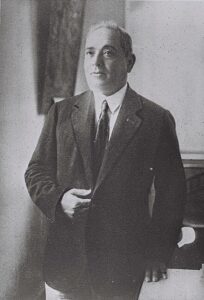
Meir Dizengoff (Feb. 25, 1861- Sept. 23, 1936) was born in Bessarabia (today Moldova & Ukraine) to Orthodox Jewish parents. The family moved in 1878 to Kishinev, where he attended polytechnic school. He served in the Imperial Russian Army from 1882 to 1884, during which time he met his future wife Zina Brenner. In 1885, he became involved in the Russian underground and was sentenced to eight months in jail, following which he founded the Bessarabian branch of Hovevei Zion.
In 1888, he studied chemical engineering at the University of Paris, where he met Edmond James de Rothschild, who sent him to Ottoman-ruled Palestine to establish a glass factory in Tantura. But impurities in the sand caused the faulure of that venture and Dizengoff’s return tp Kishinev. As a founder of the Geulah company, he purchased land in Palestine from Arab residents and helped to finance automobiles to replace horse-drawn carriages.
After moving back in 1905 to Palestine, where he settled in Jaffa, he formed a partnership with the Ahuzat Bayit company to develop land on the outskirts of Jaffa. Sixty six families drew lots for housing locations along the beach from which the city of Tel Aviv would grow. The Dizengoffs were among those first families, and he served as head of town planning from 1911 to 1922. When Tel Aviv was recognized as a city, Dizengoff was elected as its first mayor.
During World War I, Ottomans exiled a large portion of Tel Aviv’s population and Dizengoff became a spokesperson for them, persuading the rulers to provide them food and provisions. Like many Jews in Palestine at the time, Dizengoff supported the Ottomans in their war against the British.
After the Arab riots of 1921, Dizengoff persuaded the British mandate to recognize Tel Aviv as a separate municipality from Jaffa. He persuaded the Zionist philosopher Ahad Ha’am (born Asher Zvi Hirsch Ginsberg), the poet Chaim Bialik, and the artist Reuven Rubin to settle in Tel Aviv. After his wife died, Dizengoff donated his home to the City of Tel Aviv, which remodeled it as an Art Museum. On May 14, 1948, the museum was the venue at which David Ben-Gurion declared Israel’s independence. It subsequently was renamed as Independence Hall and was converted into a history museum. Shortly before his death, Dizengoff persuaded the British Mandatory authorities that Tel Aviv should have its own port, separate from Jaffa’s.
Tomorrow, February 26: Levi Strauss
*
SDJW condensation of a Wikipedia article